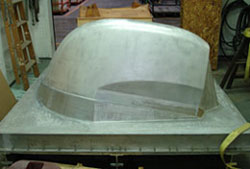Tooling Engineering

Tooling Engineering for the Thermoforming and Fiberglass Reinforced Plastic process begins at the part design stage. When a part concept is brought to McClarin Composites, our tool makers work closely with the customer and designers. This enables us to design a tooling package that will take advantage of all available technology and develop new methods of part production. Our goal is to provide the customer with the highest quality finished part for the best spent capital investment on tooling.
Thermoforming Tooling
The finished quality of a thermoformed plastic part begins in the tooling design stage. If shortcuts are allowed in the tooling construction or design stage, then the customer will be left with a substandard part. In order to achieve the highest possible quality, we incorporate the following state of the art practices. Wooden patterns are computer control machined directly from the part file. This removes any manually made pattern errors. Wooden patterns are used to make production cast aluminum temperature controlled vacuum molds. Master patterns or what are referred to as prototype molds are also computer control machined. The Master Pattern allows the customer to make a limited number of sample parts prior to an actual production mold being made. This saves added expense in case a design change is needed that wasn’t foreseeable in the drawing stage. It also allows the customer to check fit and function of the plastic parts without too much expense.
The best possible tooling that can be used for Thermoforming is a cast aluminum temperature controlled vacuum mold. These molds are cast directly from the wood pattern or master pattern. The molds use coolant to control part temperature during the forming stage. This allows the use of a wider range of materials over a non temperature controlled mold. The use of cooled molds also controls part size, forming of more difficult shapes and specific part features.
 Assembly fixture for a vacuum formed radiator surround
Assembly fixture for a vacuum formed radiator surroundAll Thermoformed parts that are manufactured at McClarin Composites are trimmed using 5 axis computer controlled routers. The parts are held in place during the trimming phase using vacuum assisted fixtures. These fixtures utilize the latest in vacuum cup technology developed over years of part trimming experience.
If a Thermoformed part requires any assembly of subcomponents after the forming and trimming phases an assembly fixture will be used. These fixtures range in complexity from simple clamping functions to electronically controlled computer designed functions using hydraulics and pneumatics.
Fiberglass Reinforced Plastic Tooling
Fiberglass Reinforced Plastic tooling begins in much the same way as Thermoformed tooling. A wooden pattern is computer control machined from a part file. The pattern surface is then finished out to a class A automotive finish. This finishing process utilizes a coating of filled polyester resin. Once the pattern is ready a special tooling resin and glass system is used to make a reversal of the pattern. This reversal is braced using wood, steel and aluminum to reinforce and hold its original shape. The reversal that is now braced will be used as the production mold. The production mold surface is also finished to a class A automotive finish. The final quality of the finished part directly relates to the efforts taken in the pattern and mold surface finishing stages. A poorly finished surface on either the pattern or mold will result in a fiberglass part that is of a lesser surface quality.
Fiberglass parts are trimmed using either a 6 axis high speed robot or manual trimming and drilling jigs. The fixtures used for part trimming by the robot are constructed of aluminum and also use a vacuum assisted fixture.
Like thermoformed tooling, if a fiberglass part requires any subassembly, then similar fixtures are constructed to aid in that function.
